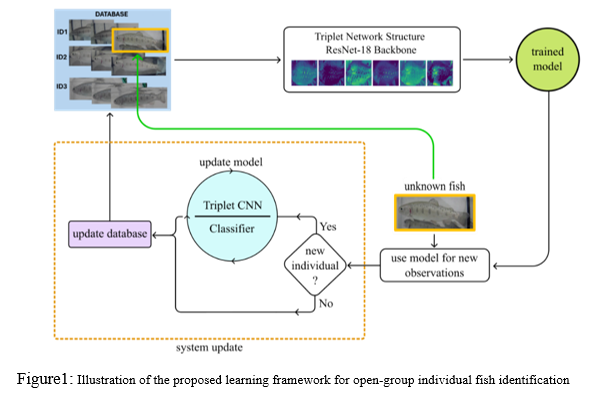META-LEARNING ENHANCED CNN TRANSFER LEARNING FOR INDIVIDUAL FISH IDENTIFICATION IN WILD POPULATIONS
Introduction
Accurate monitoring of individual fish within their natural settings is needed for ecological studies, conservation schemes, and sustainable fisheries management. A reliable, non-invasive identification system could provide valuable insights into health, and population dynamics with minimal effect on their ecological routines . However, no specific, standardized method currently exists for individual fish identification in wild and open-group populations. Developing such a farmework may seem impractical due to the visual similarity among individuals. Nevertheless, recent advances in artificial intelligence particularly in computer vision, convolutional neural networks (CNNs) for performing biometric tasks [1], transfer learning, and meta-learning offer a promising pathway toward automating this challenging task [2]. Herein , we present a prototype of a meta-learning-based biometric system developed to identify and match individual rainbow trout. The system was evaluated using data collected over a 70-day period from rivers across the Czech Republic. Preliminary results from the individual matching via developed system demonstrate promising outcomes, highlighting the potential of this approach for reliable open-group identification in natural water bodies .
Materials and methods
Dataset
We utilized an open-group dataset, which included still images of trout captured out of the water. All fish were consistently oriented to the same side for image capturing to ensure uniformity. Data collection was carried out over 10 sessions, and i n each session, fish were carefully captured from the river, photographed, and subsequently released back into the sampling fishing site. At the conclusion of the data collection process, the dataset consisted of 535 images representing 425 individuals . Among these, 67 individuals were observed across multiple more than one time across sessions, providing valuable data for cross-session matching. Expert annotators manually label led the dataset to match the same individuals across different sessions. Both individuals who appeared more than once and those captured only once were assigned unique class labels (ID of individuals). These labelled classes served as the basis for training and evaluating the proposed biometric identification system.
Methodology
The proposed system utilizes a triplet network with a ResNet-18 backbone for individual identification of trout. This method employs an incremental learning strategy, enabling the system to add new classes of individuals to update the model and database progressively. The model is trained from scratch on a dataset including five known individuals. After each training cycle, t he model compares newly observed individuals with the existing database, adding into the individual’s set if a match is found or assigning the image as a new class in case no match is detected. The model is continuously retrained after each cycle of database update with the transferred weights from the previous phase and improves the generalization ability effectively. A thresholding strategy is employed to balance the trade-off between confidence in matching and the risk of class fragmentation of the same individuals . This framework supports few-shot learning, enabling robust re- identification for limited observations.
Results
The preliminary results of the proposed method achieved a Top-1 identification accuracy of 80.3% at the final stage of the incremental learning process. A class prediction probability threshold of 0.33 yielded optimal performance, and few-shot evaluations on the dataset showed 84% accuracy with three or more observations per individual. The model also maintained strong identity grouping, with an Identity Consistency Rate of 89.7% and a Class Purity of 92.1%.
Conclusion
This study presented an incremental, meta-learning-based system for individual identification of open-group trout. The results demonstrate that the open-group identification of fish species can be achievable with a low number of observations per individual. By using a progressive learning strategy, the model achieved a satisfactory Identity Consistency Rate and Class Purity metrics, effectively demonstrating its ability to adapt to new individuals. This method also holds potential for practical applications in the field of aquaculture. Further development of the proposed system could provide a promising solution not only for ecological monitoring but also for advancing automated stock management in aquaculture.
Acknowledgement : This work was carried out with the support of VVI CENAKVA Research Infrastructure (ID 90238, MEYS CR, 2023–2026), and GAJU 114/2022/Z . We thank Pavel Jarajda and Ana Šindelářová from the Czech Academi of Science for providing the dataset.
References:
[1] Cisar, P., Bekkozhayeva, D., Movchan, O., Saberioon, M., & Schraml, R. (2021). Computer vision based individual fish identification using skin dot pattern. In Scientific Reports (Vol. 11, Issue 1). Springer Science and Business Media LLC. https://doi.org/10.1038/s41598-021-96476-4.
[2 ] Xu, X., Wang, Y., Shang, Y., Yang, G., Hua, Z., Wang, Z., & Song, H. (2025). Few-shot cow identification via meta-learning. In Information Processing in Agriculture (Vol. 12, Issue 1, pp. 80–90). Elsevier BV. https://doi.org/10.1016/j.inpa.2024.04.001.
